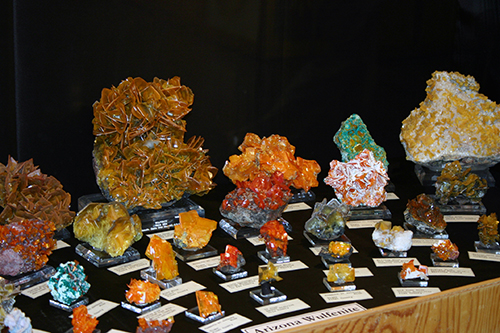
By Bob Jones
In part one of this series (enjoy Part I) we described wulfenite from several Arizona mines including the famous town of Tombstone, which is best known for silver and the gunfight at the OK Corral. Better know for wulfenite and rare copper-lead species is the town of Tiger and its Mammoth-Saint Anthony mine. Less well known, except among Arizona mineral collectors, is the Rowley mine which yields some of the prettiest wulfenite-mimetite specimens in the state.
You’ll have a chance to see and enjoy Arizona’s wulfenites at the world-famous Tucson Gem and Mineral Show®, which features wulfenite as this year’s theme. The choice of wulfenite is a good one since the city of Tucson is the center of well over 200 localities that have produced wulfenite.
Evolution of A Mineralogy Center
Since the Tucson Show started in 1955 the city of Tucson has evolved through the decades to fast become a world mineralogy center. In 2020, when Tucson’s world known mineral event happens the new University of Arizona Museum will open in downtown Tucson, making the community an actual World Center of Mineralogy.
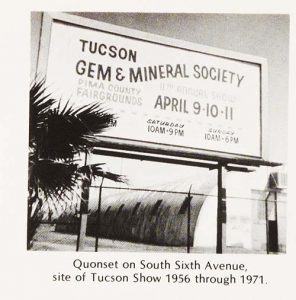
How could all of this happen? The first years of the Tucson Show were ordinary club events like so many others. In fact, 120 miles north of Tucson was the annual Phoenix mineral show that was the largest and most popular mineral show in the southwest.
The first important move the Tuscon club made toward growth was to move the show to February instead of the original April date. With a show in winter, the rest of the country realized Tucson was the place to be in February. It made Tucson more attractive to anyone living in the northern states when the show had moved to an old World War II vintage Quonset Hut on the Fairgrounds south of downtown Tucson.
Coincidentally, a flood of fine mineral specimens from Mexico was pouring into Tucson from mines that closed after World War II. The out-of-work miners realized they could make living selling minerals. Dealers would do the Phoenix Show and the young TGMS Show, then restock at Tucson’s wholesale dealers and even making a quick trip into Mexico for specimens. It was inevitable Tucson as a show venue would grow.
Inviting Speakers and Setting Exhibits
The next very significant move the Tucson Club made was in 1960 when Show Chairman Clayton Gibson wrote to Smithsonian’s Paul Desautels inviting him to be a speaker and bring an exhibit to the 1961 Show. Desautels jumped at the chance to vacation in sunny Arizona, the first time Smithsonian had brought a display to a club show. They’ve been doing it ever since!
The exhibit Paul Desautels brought was specimens of rare and valuable silver species from the Carl Bosch collection. Bosch was a rich German who had developed the ammonia making process. After his death, his family shipped his collection to America and housed it for sale at Yale University. I saw the Bosch display in 1948 and when Desautels knew it was for sale he raised the money to buy it. It took two huge moving vans to move it to the Smithsonian.
Desautels and the Smithsonian joining the Tucson Show turned it into a national event. This was followed by a Dick Bideaux suggestion to invite his friend Peter Embrey, curator of the Museum of Natural History, London, England to bring an exhibit and to lecture. Pete accepted in 1971 and suddenly Tucson was an International Show. Pete and I became good friends and I was able to stay with him in London during several visits.
By the 1970s the Tucson Show had become so important far more mineral dealers were applying for show space than the newly built Convention Center could hold. Dealers who could not be in the TGMS Show set up in hotels and motels or simply set up on street corners. Tents were erected in motel parking lots and every available building was eventually rented by show promoters. By the 1990s dozens of collectors and dealers had acquired homes or storage facilities to have a base of operations year round. All this has resulted in Tucson now hosting about 50 mineral, gem, and fossil shows each year and still growing. From late January into mid-February Tucson hosts well over a hundred thousand rockhounds and visitors.
Eyes on Wulfenite
With this historical background of the growth of the Tucson Show, you should better
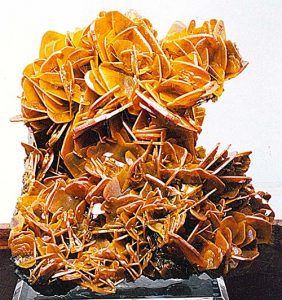
appreciate the 2019 Tucson Gem and Mineral Show and its exhibits of world-famous wulfenite from Arizona’s many mines including the Red Cloud mine, the Glove mine, Old Yuma mine along with wulfenite from world localities in Mexico, Africa, and Europe.
Arizona’s wulfenite localities have produced their share of tales and legends. For example, how about the pocket of wulfenite discovered when an ex-policeman rockhound shot at a flash of color on a mine wall? Or, how about collecting in a cave lined with marvelous and unique wulfenite crystals?
The City of Tucson is bracketed by two well-known wulfenite deposits, the Old Yuma mine, and the Glove mine. Each has a story to tell.
The Old Yuma mine was a gold mine in the 1800s, but once it was closed local collectors began enjoying collecting fine red vanadinite specimens in quantity and choice bright orange to orange-red tabular wulfenite crystals. The mine is so close to Tucson you can stand on an Old Yuma mine dump and see downtown Tucson.
Unexpected Discovery
One friend of mine, Dick Jones, was a regular at Old Yuma. One day he was collecting and took time eating his lunch sitting on the side of mine’s open pit. He noticed a bright yellow spot on the opposite wall of the pit. Being an ex-policeman, Dick pulled out the revolver he carried to avoid snakes and such and took a shot at the colorful spot. To his surprise, the bullet cracked open a small wulfenite pocket! That is the only time I ever heard of someone using lead to find lead minerals!
Old Yuma was a group of patented claims privately owned by Dick Bideaux. As mineral values grew Dick formed a specimen collecting group to mine Old Yuma for wulfenite and vanadinite. A new incline was installed and serious underground mining was done in the 1980s. I, along with my son Evan, enjoyed a little underground collecting while this operation was going on.
The problem with the Old Yuma and all this mining activity was the claims bordered the Western Section of Saguaro National Monument and Federal employees were not happy about the mine activity activities next door. Eventually, Bideaux and Federal representatives began discussions regarding the sale of the property. Dick set his price, which was six figures, but the Feds did not wish to meet it. Days, weeks, months went by with little progress. Finally, Dick made plans to start gold mining the Old Yuma. He drew up plans to set up a cyanide leaching process plant to recover gold. Suddenly, the Old Yuma quickly became part of Saguaro National Monument and mineral collecting and mining ceased.
South of Tucson is another noteworthy wulfenite locality, the Glove mine.
Unique Examples of Wulfenite
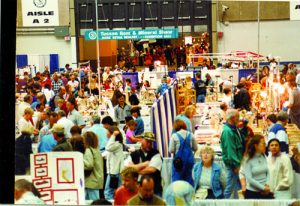
For almost all of its operating and closed life, the Glove mine produced only small amounts of pretty good wulfenite. I tried my hand at underground collecting there, which was marginal at best. But in the 1950s the Glove mine did have one stellar discovery. Formal mining had opened a cave completely lined with superb wulfenite crystals. The mine operators realized they had a significant find so George Bideaux, Dick’s father was told and Dick and a collector friend, Bob Hagg, set up a specimen mining operation to clear the cave.
Glove wulfenite has a unique color, a fine yellow tan in tabular crystals. The crystals often show a gradual darkening toward the crystal edges, and all of the crystals are octagonal shaped like a stop sign. What is amazing is the consistency of the size and color of any given specimen.
Most crystals have a sub-adamantine luster and range from a half inch to just over an inch on an edge and are so tightly clustered no matrix is visible. Specimens mined here are instantly recognizable because of their unique crystal form, color, and tight clustering.
Today, thanks to that one specimen mining effort Glove mine wulfenite is found all over the world. The “pocket,” once mined out was so big two of us could crawl in on our hands and knees and sit comfortably while hoping to find specimens.
Unique and Uncommon Wulfenite
It took Dick and Bob several days to recover all the Glove mine specimens as they had to be extra careful. Fortunately, the matrix was not too tough so recovery efforts were very successful as evidenced by a large number of Glove wulfenite specimens still extant.
Once the cave was depleted of wulfenite specimens the two men had an interesting problem. How to do you market hundreds of wulfenite specimens that are almost all about the same excellent quality, size and form? How do you even price them? The specimens are unique and quite unlike any wulfenite found elsewhere. Their collecting had recovered the wulfenite in specimens all pretty much the same size averaging about 4 x 5 inches across.
There were many larger and smaller specimens but the 4 x 5 specimen size was pretty
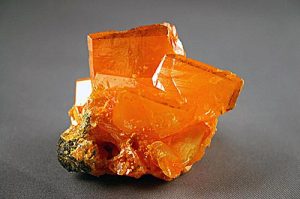
constant. They realized if specimens of this size were priced, the other sizes would fall into place. They decided 4 x 5 specimens would be the standard size or unit upon which to base a sale price. Specimens exceeding a 4 x 5 inch size or had some exceptional feature that would be priced accordingly.
And what did they decide should be the price of a typical 4 x 5 wulfenite specimen from the Glove mine? Would you believe $5 each? Think of that when you are admiring Glove wulfenite specimens on display at the 2019 Tucson Show.
Historically, the first mention of wulfenite dates back well over 150 years when it was first described in Europe by Franz Xavier Wulfen of Austria. Since that time this lovely lead molybdate has been found as a secondary mineral in countless countries around the world. But Mother Nature is very selective about where she forms minerals.
Come for the Wulfenite and See the Sights
If you were to decide to visit the famous or renowned wulfenite locations you had better take plenty of water as wulfenite is best formed in dry, desert climes like the American Southwest. Almost all eye-catching wulfenite specimens you’ll see displayed at museums, private collections and at the Tucson Show are from desert regions and formed only where lead and molybdenum atoms were available. Luckily, the Southwest Desert of Arizona and the Sonora Desert of Mexico have both elements. You will never again see a greater variety and quantity of wulfenite than you’ll see in Tucson this year.
Part III of this article will bring some of those fruitful localities to light.
Author: Bob Jones
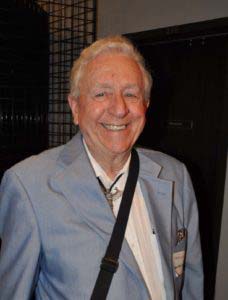 Holds the Carnegie Mineralogical Award, is a member of the Rockhound Hall of Fame, and has been writing for Rock & Gem since its inception. He lectures about minerals, and has written several books and video scripts.
Holds the Carnegie Mineralogical Award, is a member of the Rockhound Hall of Fame, and has been writing for Rock & Gem since its inception. He lectures about minerals, and has written several books and video scripts.















